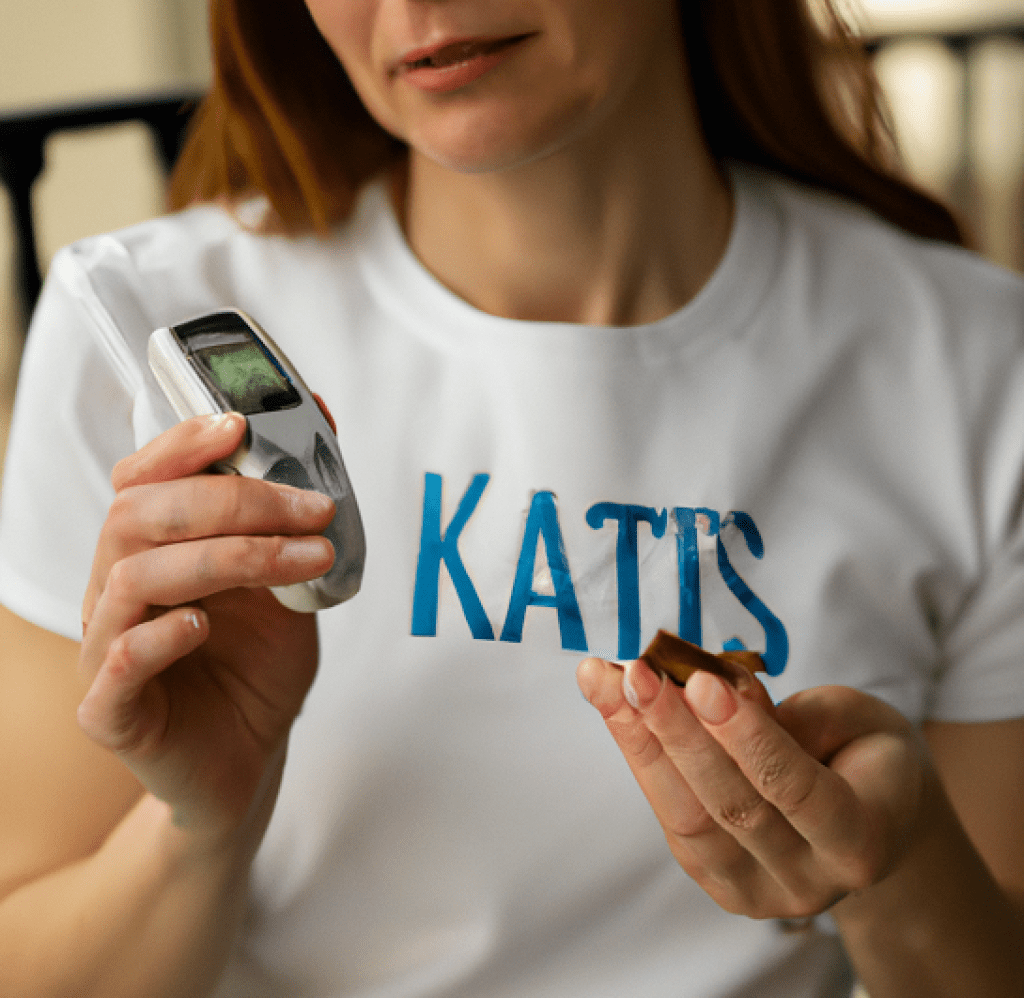As an Amazon Associate I earn from qualifying purchases.
Unlocking Ketosis: A Comprehensive Guide to Signs & Symptoms
Embracing the ketogenic lifestyle involves a metabolic shift where the body becomes adept at burning fats for energy, ushering in a state known as ketosis. Recognizing the signs and symptoms of ketosis is crucial for those navigating this low-carb, high-fat dietary approach. This comprehensive guide delves into the key indicators, shedding light on the intricacies of ketosis.
Sign & Symptom 1 Increased Ketone Levels:
- The cornerstone of ketosis lies in elevated ketone levels. Monitoring these ketones through blood, urine, or breath tests provides tangible evidence of the body's transition. Utilizing ketone testing strips or meters offers quantitative insights into ketone production [1].
Symptom 2 Weight Loss:
- One of the primary goals of the ketogenic diet is weight loss. As the body shifts from glucose to fat as its primary fuel source, stored fats are efficiently burned, leading to noticeable weight loss [2].
Sign 3 Enhanced Mental Clarity:
- The cognitive benefits of ketosis are well-documented. Users report improved mental focus, clarity, and enhanced cognitive function, attributed to the brain's efficient utilization of ketones [3].
Sign & Symptom 4 Suppressed Appetite:
- Appetite suppression is a common outcome of the ketogenic diet. The satiating effects of fats, coupled with stabilized blood sugar levels, contribute to reduced hunger [4].
Sign 5 Increased Energy Levels:
- Although the initial adaptation to ketosis may induce fatigue, many individuals report sustained energy levels once fully adapted. The body becomes proficient in utilizing ketones for energy [5].
Symptom 6 Changes in Breath Odour:
- A distinctive change in breath odour is often noted in those in ketosis. The fruity or acetone-like scent is a byproduct of increased ketone production [6].
Sign 7 Short-Term Performance Dip:
- Some individuals experience a transient decline in physical performance during the initial stages of ketosis. However, long-term endurance and performance often see improvement [7].
Sign 8 Changes in Urine Odor:
- Elevated ketone levels can manifest in changes in urine odour. The sweet or fruity smell is indicative of increased ketone excretion [8]. If you want to know why your urine or pee smells different in ketosis while you are on the keto diet read here.
Symptom 9 Digestive Changes:
- The shift in dietary composition can influence bowel habits. While some individuals may experience constipation, others notice improved regularity on a ketogenic diet [9].
Symptom & Sign 10 Reduced Water Retention:
- Initial weight loss on keto often involves shedding excess water retained with higher carbohydrate intake. This reduction in water retention contributes to visible changes in body composition [10].
Important Note: While recognizing these signs is pivotal, it's imperative to differentiate between ketosis and ketoacidosis, a potentially perilous condition. If uncertainty or severe symptoms arise, seeking guidance from a healthcare professional is paramount.
Conclusion: Navigating the intricacies of ketosis involves mindfulness of these signs and symptoms. Individual responses to ketosis can vary, and understanding the nuances ensures a safe and effective journey into the state of ketosis.
References: [1] Westman, E. C., & McKenzie, A. L. (2002). Is dietary carbohydrate essential for human nutrition? The American Journal of Clinical Nutrition, 75(5), 951–953.
[2] Brehm, B. J., et al. (2003). A Randomized Trial Comparing a Very Low Carbohydrate Diet and a Calorie-Restricted Low Fat Diet on Body Weight and Cardiovascular Risk Factors in Healthy Women. The Journal of Clinical Endocrinology & Metabolism, 88(4), 1617–1623.
[3] Page, K. A., et al. (2013). Medium-chain fatty acids improve cognitive function in intensively treated type 1 diabetic patients and support in vitro synaptic transmission during acute hypoglycemia. Diabetes, 62(2), 514–523.
[4] Johnstone, A. M., et al. (2008). Effects of a high-protein ketogenic diet on hunger, appetite, and weight loss in obese men feeding ad libitum. The American Journal of Clinical Nutrition, 87(1), 44–55.
[5] Volek, J. S., et al. (2016). Metabolic characteristics of keto-adapted ultra-endurance runners. Metabolism, 65(3), 100–110.
[6] Musa-Veloso, K., et al. (2002). Breath acetone is a reliable indicator of ketosis in adults consuming ketogenic meals. The American Journal of Clinical Nutrition, 76(1), 65–70.
[7] Zinn, C., et al. (2017). Ketogenic diet benefits body composition and well-being but not performance in a pilot case study of New Zealand endurance athletes. Journal of the International Society of Sports Nutrition, 14(1), 22.
[8] Musa-Veloso, K., et al. (2006). Acetoacetate excretion by humans increases with increases in dietary ketosis. Journal of Nutrition, 136(7), 1595–1600.
[9] Paoli, A., et al. (2015). Beyond weight loss: a review of the therapeutic uses of very-low-carbohydrate (ketogenic) diets. European Journal of Clinical Nutrition, 69(8), 871–876.
[10] Paoli, A., et al. (2013). Exercising fasting or fed to enhance fat loss? Influence of food intake on respiratory ratio and excess postexercise oxygen consumption after a bout of endurance training. International Journal of Sport Nutrition and Exercise Metabolism, 23(6), 529–534.
The ketogenic diet is a low-carb, high-fat diet that aims to put the body in a metabolic state called ketosis. In this state, the body burns fat for fuel instead of carbohydrates. Achieving and maintaining ketosis is key to the success of the ketogenic diet, and it can be difficult to know if you are in ketosis or not.
Here are some signs that you are in ketosis to look out for:
- Weight loss: One of the primary goals of the ketogenic diet is weight loss. When the body is in ketosis, it burns fat for energy, which can lead to significant weight loss over time.
- Increased energy: Many people report feeling more energetic and alert when they are in ketosis. This is because the body is using fat for fuel instead of carbohydrates, which can lead to a more stable energy level throughout the day.
- Reduced appetite: The ketogenic diet can lead to a reduction in appetite, which can make it easier to stick to the diet and achieve ketosis.
- Bad breath: When the body is in ketosis, it produces a type of ketone called acetone, which can lead to bad breath. This is often described as a fruity or metallic taste in the mouth.
- Increased ketones in the blood: One of the most reliable ways to determine if you are in ketosis is to measure the level of ketones in your blood. This can be done using a blood ketone meter, which measures the level of beta-hydroxybutyrate (BHB) in the blood.
- Increased ketones in the urine: Another way to measure ketones is to use urine test strips. These strips measure the level of acetoacetate in the urine, which is another type of ketone.
- Reduced muscle cramps: Many people report a reduction in muscle cramps when they are in ketosis. This may be due to the fact that the body is better able to utilize electrolytes when it is in ketosis.
- Improved mental clarity: Some people report improved mental clarity when they are in ketosis. This may be due to the fact that the brain is using ketones for fuel instead of glucose.
Tips for Achieving Ketosis:
- Limit your carbohydrate intake: The key to achieving ketosis is to limit your carbohydrate intake to 20-50 grams per day. This will vary depending on your individual needs and goals.
- Increase your fat intake: In order to burn fat for fuel, you need to eat plenty of healthy fats. This includes foods like avocados, nuts, seeds, and fatty fish.
- Monitor your protein intake: While protein is an important part of the diet, too much protein can kick you out of ketosis. Aim for a moderate protein intake of around 20-25% of your daily calories.
- Stay hydrated: It is important to drink plenty of water when you are on the ketogenic diet. This will help to flush out toxins and keep you feeling full.
- Exercise regularly: Exercise can help to speed up the process of achieving ketosis by burning off glycogen stores and increasing insulin sensitivity.
In conclusion, achieving and maintaining ketosis is key to the success of the ketogenic diet. By following the tips and looking out for the signs of ketosis, you can stay on track and achieve your weight loss and health goals. Remember, it is important to listen to your body and make adjustments as needed to ensure that you are getting the most out of the ketogenic diet.

How does it feel to be in ketosis?
Ketosis is a metabolic state that occurs when your body switches from burning glucose to burning stored fat as its primary source of energy. This state is achieved through a low-carbohydrate, high-fat diet, such as the popular ketogenic diet.
Many people wonder how it feels to be in ketosis, so here are some signs and feelings that you might experience:
- Increased energy: Once you are in ketosis, you may feel more energized and focused throughout the day. This is because your body is efficiently using stored fat for fuel instead of relying on glucose.
- Decreased appetite: Many people report feeling less hungry and having fewer cravings once they are in ketosis. This may be due to the higher fat content in your diet, which helps you feel fuller for longer.
- Bad breath: Unfortunately, one common side effect of ketosis is bad breath. This is caused by the production of ketones, which can have a distinct odor.
- Increased thirst: Ketosis can cause your body to excrete more water, leading to increased thirst.
- Weight loss: If your goal is to lose weight, being in ketosis can be a helpful tool. By burning stored fat for fuel, you may see a reduction in body fat over time.
It can take anywhere from a few days to a few weeks for your body to enter ketosis, depending on your individual metabolism and the strictness of your diet. However, once you are in ketosis, you may experience some or all of these feelings and signs.

What does keto breath smell like?
Keto breath is a common side effect of being in ketosis, and it can have a distinct smell.
Here are some descriptors of what keto breath might smell like:
- Fruity: Some people describe the smell of keto breath as fruity, similar to the scent of acetone.
- Metallic: Others say that keto breath has a metallic smell, almost like a metallic taste in the mouth.
- Sweet: While keto breath isn't exactly pleasant, some people find that it has a slightly sweet smell.
- Acrid: For some people, keto breath can have an acrid or pungent smell, similar to the scent of ammonia.
Overall, keto breath can vary in smell and intensity from person to person. It's important to stay hydrated and practice good oral hygiene to minimize the effects of this common side effect.

Testing for Ketosis: A Comprehensive Guide
If you're following the ketogenic diet, you may want to test whether or not you're in ketosis. Measuring ketone levels can help you confirm if your diet and lifestyle choices are putting you in the optimal state for fat burning and weight loss. There are several ways to test for ketosis, from using at-home urine test strips to more accurate blood tests.
Urine Test Strips
Keto urine test strips are a cheap and convenient way to test for ketosis. They work by measuring the levels of acetoacetate, one of the ketones produced when your body is in ketosis, in your urine. Here's how to use urine test strips:
- Collect a urine sample in a clean, dry container.
- Dip the test strip into the urine and shake off any excess.
- Wait for the strip to change color. Match the color of the strip to the color chart on the packaging to determine the level of ketosis.
While urine test strips are an easy way to test for ketosis, they're not the most accurate method. They can give false readings if you're dehydrated, taking certain medications, or have been in ketosis for a long time.
Breath Testers
Breath testers measure the level of acetone, another ketone, in your breath. They work by measuring the concentration of acetone in your breath, which is a byproduct of ketosis.
Here's how to use a breath tester to test for ketosis:
- Turn on the device and wait for it to warm up.
- Blow into the device for a specified amount of time.
- Wait for the device to display your acetone level.
Ketone breath testers are more accurate than urine test strips, but they can be expensive and require calibration.
Blood Tests
Blood tests are the most accurate way to test for ketosis. They measure the level of beta-hydroxybutyrate (BHB), the main ketone produced when you're in ketosis, in your blood. The best and easiest way to test the blood for ketones is with a blood ketone meter.
Here's how to use a blood ketone meter:
- Prick your finger with a lancet and collect a small drop of blood.
- Insert the test strip into the meter.
- Apply the blood to the test strip.
- Wait for the meter to display your BHB level.
Blood tests are the most accurate method for testing ketone levels, but they're also the most expensive and invasive. Blood tests may not be necessary for everyone, but they can be helpful if you're having trouble getting into ketosis or if you want to confirm that you're in ketosis.
Signs of Ketosis
In addition to testing for ketosis, there are several signs that you may be in ketosis. Here are some of the most common signs of ketosis:
- Increased Energy Levels: When your body is in ketosis, it's burning fat for fuel instead of carbs. This can lead to increased energy levels and mental clarity.
- Reduced Appetite: Ketones can help suppress appetite, which can lead to weight loss.
- Metallic Taste: Some people report a metallic taste in their mouth when they're in ketosis.
- Increased Thirst: As your body burns fat, it releases water, which can lead to increased thirst.
- Keto Breath: When your body is in ketosis, it produces acetone, which can cause bad breath.
- Weight Loss: One of the most common reasons people follow the ketogenic diet is for weight loss. If you're in ketosis, you may notice that you're losing weight.
Conclusion
Testing for ketosis can help you confirm whether or not you're in the optimal state for fat burning and weight loss. There are several methods for testing ketone
Amazon and the Amazon logo are trademarks of Amazon.com, Inc, or its affiliates.






